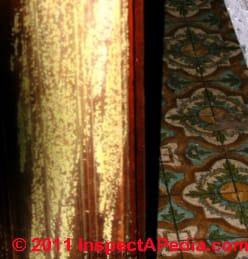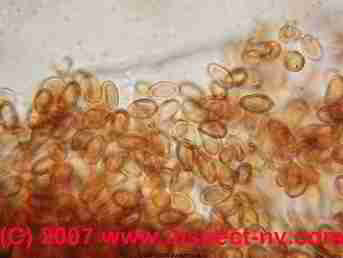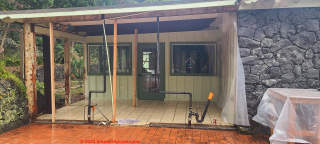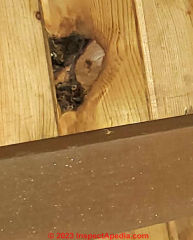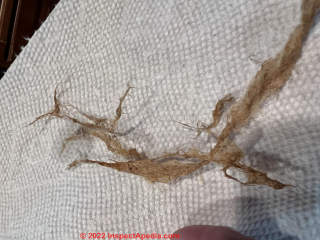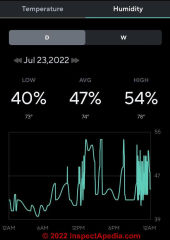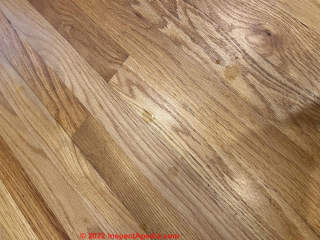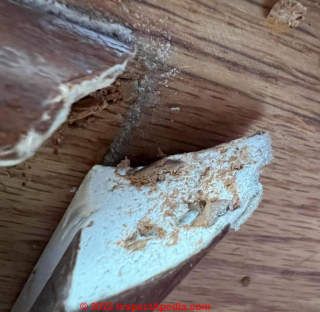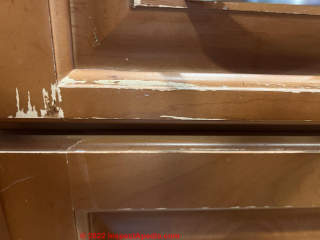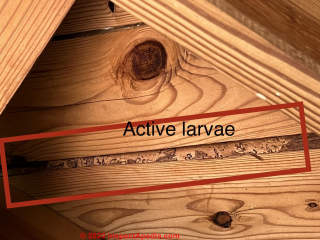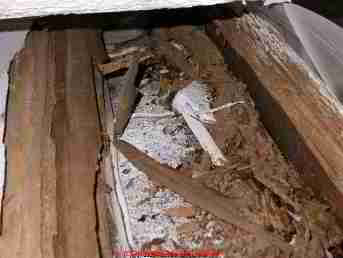 Meruliporia incrassata - "Poria" the house eating fungus
Meruliporia incrassata - "Poria" the house eating fungus
& Serpula lacrymans: infamous wood rotters
- POST a QUESTION or COMMENT about house eating fungus: Meruliporia or Serpula molds in buildings
This article describes Meruliporia incrassata or "Poria" Meruliporia incrassata, previously named Poria incrassata which is better known among reporters and repairmen who see the public pale at reports of how the "house eating fungus" destroys a home.
This is a severe wood-rot fungus (a basidiomycete) which is particularly onerous in buildings because, as some writers have claimed, it may to continue to find water for itself even after the original wet-building leaks appear to have been repaired.
InspectAPedia tolerates no conflicts of interest. We have no relationship with advertisers, products, or services discussed at this website.
- Daniel Friedman, Publisher/Editor/Author - See WHO ARE WE?
What Meruliporia incrassata fungus or "Poria" the "house eating fungus" looks like in a building
 The water-conducting fungus, Poria incrassata (Berk. and Curt.) Burt, causes the most spectacular decay of wood in buildings in the United States. It produces large, tough, water-@@s of fungal contamination and rot may be present too.
The water-conducting fungus, Poria incrassata (Berk. and Curt.) Burt, causes the most spectacular decay of wood in buildings in the United States. It produces large, tough, water-@@s of fungal contamination and rot may be present too.
In this article we also discuss the relationship among Meruliporia, termite, and other insect damage.
Article Series Contents
- MERULIPORIA HOUSE EATING FUNGUS
- MERULIPORIA DAMAGE - What does Poria look like? Why do Meruliporia or Serpula House-Eating Fungi Cause So Much Damage to Wood Structures?
- MERULIPORIA under the MICROSCOPE - Photographs of Meruliporia incrassata in buildings and under the microscope
- MERULIPORIA DAMAGE MECHANISM - Details about how Meruliporia incrassata causes rot & how it grows in buildings
- MERULIPORIA FUNGUS REMEDIES - What to do about Meruliporia incrassata when it is found in a building - how much wood to remove?
- MERULIPORIA vs SERPULA - What is the Difference Between Meruliporia incrassata and Serpula lacrymans? Many Poria names, some describe the same organism or members of its family.
- MERULIPORIA FUNGUS & TERMITE INTERACTIONS - [separate article] do termites cause, or benefit from, or are they repelled by Poria or other fungi?
- PORIA DAMAGE PREVENTION - [separate article] how to prevent Poria or Meruliporia "house eating" fungus damage to wood structures
To obtain its moisture, this fungus has been observed to extend long rhizomorphs through wood structural and non-structural members, both inside the wood and even on other surfaces. It is capable of extending its water supply pumping rhizomorphs over considerable distances to find a needed moisture source.
That's why the repair advice is to remove 24 inches or more of wood BEYOND any visible damage and rot.
Otherwise you're not getting rid of all of the infected material, and the fungus may re-grow quickly. Not all mycologists agree with this characterization of Meruliporia incrassata, as I elaborate below.
Meruliporia or Serpula House-Eating Fungi Appearance & Damage
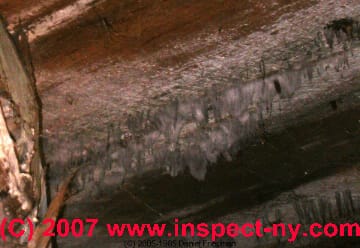 Both Meruliporia incrassata and Serpula lacrymans [or lacrymans] are capable of causing very extensive damage to wood structures.
Both Meruliporia incrassata and Serpula lacrymans [or lacrymans] are capable of causing very extensive damage to wood structures.
Here we illustrate are some Meruliporia rhizomorphs suspended under wood flooring. At left in the photo you can see some white fungal material that may be a Poria fruiting body.
A particularly notorious wood-rotting species is Serpula lacrymans, which causes a condition commonly known as dry rot.
During the days of wooden ships, this fungus was a major cause of serious and widespread decay of sailing vessels (see Findley, 1982). In this regard, one James Sowerby (1752-1822) is said to have been the first consulting mycologist, having been hired by the [British] Royal Navy to reduce losses to decay in British warships.
Even today S. lacrimans is still important, primarily in Europe, where the dreaded dry rot causes tremendous damage to wooden structural elements and floors in houses and other buildings. The destructive effects are comparable to termite damage done to wooden structures in the United States. - Alexopolous et als. p6
In comprehending the ferocious ability of these wood-rotting fungi to attack buildings it is helpful to understand the powerful ability of these fungi to transport water rapidly and over distance.
In fact the possibility of very long distances between their rhizomorphs and a distant mycelium front explains why when we find this fungus attacking a building we (and experts) recommend cutting back wood components six feet or more from any visible fungal infection.
We have already mentioned Serpula lacrimans and related wood species as dry rot fungi. The work of Thompson and her colleagues (1985) has shown that the velocity of water movement through rhizomorphs from the food source to the distant mycelium front may be as rapid as 475 cm per hour, depending upon external factors. It is furthermore interesting that in northern Europe the fungus is seldom collected outside of buildings.
This is one species that appears to do well in the human-modified environment. - Alexopolous et als p 588
Below is shown some yellow fungus on wood wainscot which I suspected were more Meruliporia incrassata fruiting body material.
But another field photograph of mold growth shows (below left ) this fungus can also appear as dark brown on in areas of severe water damage - in this case on pine paneling (below).
Below: dark brown dusty fungal material at a concrete block foundation wall. Notice the water stains and efflorescence on the lower wall, clues telling us that this has been a wet area.
Sending water under that vinyl flooring is an engraved invitation to Meruliporia, particularly if there is a wood subfloor under that vinyl.
It was at first (to Poria novices) a surprise to find Meruliporia among the brown crud showing at the base of this concrete block wall in another water-damaged building.
But in fact depending on the age of its fans or rhizomorphs or remnants Poria may appear in colors from white to gray to yellow to dark brown.
I believe that the wood subfloor beneath that vinyl sheet flooring was the host material for this mold colonization. The fungus likes to spread through dark damp or wet spaces.
What Meruliporia incrassata mold spores look like under the microscope
Here is what Meruliporia incrassata spores look like in our lab. The spores in these lab photographs of Meruliporia incrassata were collected from buildings I inspected, including a surface sample found in a crawl space where they appeared as a "yellow dust" on rotting wood.
Below is a close look (about 1200x) at a single Meruliporia spore; notice the double walls and the pore at one end.
Meruliporia incrassata, "Poria", Merulius lacrymans, and Serpula lacrymans - Getting the Fungal Names Right
What is the Difference Between Meruliporia incrassata and Serpula lacrymans?
Serpula lacrymans has been mistaken in some articles as a European "synonym" for Merulius lacrymans which I used to characterize as Meruliporia before Mr. Green was kind enough to set me straight by generously informing me (email in September 2006) that Serpula lacrymans and Meruliporia incrassata are completely different species of fungus.
Serpula lacrymans and Meruliporia incrassata belong to different families (I use bold italics to indicate the official current names in these lists:
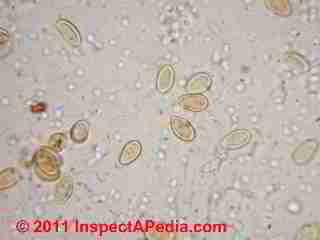
Meruliporia incrassata (Berk. & M.A. Curtis) Murrill, Mycologia 34(5): 596 (Murrill 1942)
http://www.indexfungorum.org/Names
/SynSpecies.asp?RecordID=288330
where some synonyms are listed going back to 1849:
Merulius incrassatus Berk. & M.A. Curtis, Hooker's J. Bot. 1: 234 (1849)
Poria incrassata (Berk. & M.A. Curtis) Burt, Ann. Mo. bot. Gdn 4: 360 (1917)
Serpula incrassata (Berk. & M.A. Curtis) Donk, Bulletin du Jardin Botanique de Buitenzorg, 3 S™rie 17(4): 474 (1948)
Sesia incrassata (Berk. & M.A. Curtis) Kuntze, Revis. gen. pl. (Leipzig) 2: 870 (1891)
Our photo illustrates Meruliporia found in an air sample collected during remediation of a mold and rot-damaged building.
while
Serpula lacrymans (Wulfen) J. Schr™t., Meddn Soc. Fauna Flora fenn. 11: 21 (1885) -
http://www.indexfungorum.org/Names/SynSpecies.asp?RecordID=102458
has a still longer list of synonyms:
Boletus lacrymans Wulfen, in Jacquin, Misc. Austriaca 2: 111 (1781)
Boletus obliquus Bolton, Hist. fung. Halifax: tab. 74 (1788)
Gyrophana lacrymans (Wulfen) Pat., Essai Tax. Hym™nomyc. 39(2): 108 (1900)
Merulius destruens Pers., Syn. meth. fung. (G™ttingen): 496 (1801)
Merulius domesticus H.G. Falk, Hausschwammforsch. 6: 53 (1912)
Merulius giganteus Saut., Hedwigia 16: 72 (1877)
Merulius guillemotii Boud. [as 'guillemoti'], Bull. Soc. mycol. Fr. 10(1): 63 (1894)
Merulius lacrymans (Wulfen) Schumach., Enum. pl. (Kjbenhavn) 1: 371 (1801)
Merulius lacrymans var. guillemotii (Boud.) Boud., Icon. mycol., S™r. 1 4: 84 (1905)
Merulius lacrymans var. terrestris Peck, Ann. Rep. N. Y. state Mus. 49: 45 (1897)
Merulius terrestris (Peck) Burt, Ann. Mo. bot. Gdn 4: 346 (1917)
Merulius vastator Tode, Abh. naturforsch. Ges. Halle 1: 351 (1783)
Serpula destruens (Pers.) Gray, Nat. Arr. Brit. Pl. (London) 1: 637 (1821)
Serpula domestica (Falck) Bondartsev, Priroda: 41 (1948)
Serpula terrestris (Burt) S. Ahmad, Monogr. Biol. Soc. Pakistan 6: 29 (1972)
Sesia gigantea (Saut.) Kuntze, Revis. gen. pl. (Leipzig) 2: 870 (1891)
Sistotrema cellare Pers., Syn. meth. fung. (G™ttingen): 554 (1801)
Serpula (Pers) Gray (1821), Coniophoracae. 2, widespread. S. lacrymans (syn. Merulius lacrymans), the dry rot or "house" fungus. See Cooke (1957: 201; key), Anon (Leafl. For.Prod. Res. Lab. 6, rev 1964), Harmsen (Friesia 6: 233, 1960; taxonomy, culture), Wood-attacking fungi. - Kirk et als.
Family Coniophoraceae. Members of Coniophoraceae are resupinate to pileate with a smooth or toothed hymenium. The hyphal construction of the context is usually mono or dimitic. Clamps may be present or not. However it is the basidiospores that are distinctive for the group.
The usually yellow to brown spores have smooth, double walls that take up cotton blue readily, the cyanophilous condition. In some species with large basidiospores it can be seen that only the inner wall is cyanophilous. Spores of some species also may be dextrinoid with Melzers reagent.
Another distinctive character is the brown rot produced by members of the family (Hallenberg, 1985). Based primarily on the basidiospore characters, this group long has been suggested as a relative of the boletes, and Ginns and Lefebvre (1993) placed the family in Boletales. - Alexopolous et als.
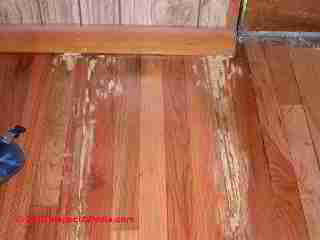 In sum, Merulius lacrymans (Boerhaave, 1720) is just one of many previous names or alternate names for what is now
Serpula lacrymans (Accum,1827). Serpula lacrymans is the current name for that fungus. Note the spelling difference too.
In sum, Merulius lacrymans (Boerhaave, 1720) is just one of many previous names or alternate names for what is now
Serpula lacrymans (Accum,1827). Serpula lacrymans is the current name for that fungus. Note the spelling difference too.
Indeed this is part of the fun of mycology. When mycologists take a break from the field and lab to get together, each time they do the result is a whole lot of shifting around, reclassifying of fungi, and changing of some of them to better or newer names. This process is bound to accelerate as more sophisticated methods for classifying fungi are put to use, such as DNA analysis.
Photo: termite and fungus-damaged wood flooring in a New York Home inspected by the author.
The traditional visual bases for taxonomic decisions about what to call things and what families to put them into is being upset and we've discovered that just because two organisms share a lot of features one cannot assume they are close relatives or members of the same family.
It was easier in the old days when Talbot's Fungal Taxonomy explained family membership based almost entirely on physical appearance and attributes. But then, he didn't have the tool of DNA analysis.
Perhaps Serpula is more commonly identified in Europe and Meruliporia more commonly identified in the U.S. - I'm no longer sure that they don't both occur in both locales.
As mycologist John Haines says, "all mold is everywhere, all the time." Readers who want to see building-damage-related articles which are often less scientifically rigorous may look up Meruliporia incrassata's reputation under "poria the house eating fungus" or "Meruliporia ..." where they will be deluged with scary articles from the real estate world (and from some home inspectors), wood preservation research, and some more scholarly articles from mycologists.
We prefer to use the Meruliporia incrassata name for this U.S. occurring brown-rot fungus. Just do a search on both names and you'll see what I mean.
Damage Mechanism: How Meruliporia incrassata grows buildings
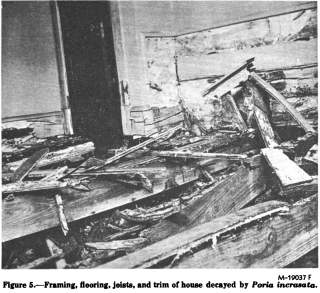 This basidiomycete is found in both new construction and in older houses which have been exposed to leaks. In new construction Poria damage may be found after just a few years and may be very extensive, stimulated by a combination of use of infected lumber at the time of construction and/or water entry or plumbing leaks.
This basidiomycete is found in both new construction and in older houses which have been exposed to leaks. In new construction Poria damage may be found after just a few years and may be very extensive, stimulated by a combination of use of infected lumber at the time of construction and/or water entry or plumbing leaks.
In older homes Poria damage may appear or have appeared at any point in the building's life, keyed to leaks or water entry. Damage may be discovered during a home inspection, a termite or wood-destroying insect inspection, or during building renovations or repairs.
A homeowner might first notice damage as flooring cracks or as visible fungal growth on wood in a basement or crawl area.
Illustration: Verra (1968) describes very extensive and rapid damage to buildings infected with Poria incrassata.
[Click to enlarge any image]
More subtly an experienced inspector might discover yellow dust indoors that might be evidence of an extensive but still-hidden Meruliporia infection of the building. I have found Meruliporia spores indoors in surface dust samples and (rarely) airborne (when there has been demolition or mold remediation ongoing). When I find these spores in a building I suspect a hidden but serious rot problem.
In a New York home I found Meruliporia spores in settled dust under a kitchen sink. Later investigation discovered a long-standing leak into the building wall and extensive decay that had not been obvious from a simple visual inspection.
Matt Green, who didn't identify himself but sounds like a mycologist who knows Meruliporia incrassata has suggested some more carefully worded facts about this fungus which I quote or paraphrase here from email received in 2006.
Wooden sills, studs, joists, subflooring, flooring and even wood contents in buildings may go from no visible damage to extensive damage or total destruction in just a few years. In part that's because an active Meruliporia infection has the ability to transport water over considerable distances and thus to support rapid fungal growth to distances of 25 feet or more from the original point of infection or water source.
Meruliporia's fungal transport of water
Fungal rhizomporphal strands do not convey water in exactly in the manner I described in the introduction, though I didn't make that version up myself. Green points out that the extended rhizomorphs sent out by Meruliporia incrassata reduce the exposed surface area of the hyphae, which in turn reduces water evaporation.
This saves water, it doesn't move it. Sarah Watkinson goes into more detail in a forthcoming book
- Fungi in the Environment, Edited by Geoff Gadd, Sarah Watkinson and Paul Dyer, Series: BRITISH MYCOLOGICAL SOCIETY SYMPOSIA 25 364 pages, 42 line diags, 48 half-tones, 10 tabs., Cambridge University Press which you will eventually be able to order at http://www.nhbs.com/title.php?tefno=147466
Decay in Buildings [due to Poria incrassata]
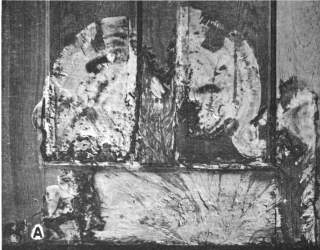 Illustration: A Poria mycelial fan, (Verrall 1968).
Illustration: A Poria mycelial fan, (Verrall 1968).
Typically, infections of Poria incrassata in buildings start in basements or crawl spaces where wood is in contact with the soil or with moist concrete or bricks.
First, papery mycelial fans ,whitish with a yellow tinge ,grow over the surface of moist wood(fig. 4,A ), or more commonly between sub - and finish floors , between joists and subfloors, or in other protected places.
If sufficient water is available, the mycelium spreads rapidly for distances up to 25 feet , destroying framing, sheathing, paneling, flooring,and other cellulosic materials.
When wood with intermediate to final decay is dried , it usually shrinks severely (fig. 5). [Shown earlier]
For this reason, dry weather may cause wide cracks to open between flooring boards(fig. 6 ).
Such cracks, or depressed areas in painted wood work, may be the first evidence of infection.
Irregular vine like rhizomorphs branching in the soil or extending to some other constant supply of water may appear on foundations, framing,or the underside of flooring (fig. 4,B ).
They are dirty white , sometimes with a yellow tinge , or with age brown to black. They commonly are 1/4 - to 1/2 -inch wide but sometimes reach 2 inches.
They have a dense outer layer and a porous interior containing enormous hyphae that probably act as water -conducting tubes(fig. 7).
Rhizomorphs may be inside brick walls with loose mortar or inside hollow blocks, or may be absent. If they are lacking, the mycelial fans appear to assume the function of conducting water.
Fans tend to develop mycelial strands resembling incipient rhizomorphs. Fruiting bodies do not always form in buildings.
When they do occur they are found on well -rotted wood in such places as cupboards or the underside of flooring. They are succulent, flat , up to 12 -inch thick , and pale olive gray with a dirty white to pale yellow margin when young.
With age they become dry and brown to black. The surface is covered with fine pores.
The fast growth of mycelial mats and rhizomorphs over the wood surface undoubtedly subjects more volume of wood to attack in a given time than does hyphal growth within the wood.
Baxter(3 ) reports that cultures grew almost twice as fast in darkness as in light.
Much of the surface spread in buildings is in the dark. - (Verrall 1968)
Remedy: What to do about fungus-infected structural wood in buildings
Green added that as long as the timber is dry, no further decay is going to occur. You might get shrinkage once the timber dries, but that's not indicative of active decay. "Current thinking is that removing the source of water, allowing the building to dry and removing decayed timber is a more sustainable approach."
He cites Timber Decay in Buildings: The Conservation Approach to Treatment, by Brian Ridout, John Fidler, Ingval Maxwell, ISBN: 0419188207, Spon Press, 1999, and available at http://www.buildingconservation.com/books/a46.htm if you're in the UK or from Amazon.com (US $80 but available used for less). This is a good book which includes advice on obtaining wood rot resistance with less reliance on environmentally harmful chemicals.
The tricky part is "as long as the timber is dry" as Green penned in his note.
Watch out: My [DF] field experience suggests that over the 20-year life of a wood-frame building, basements and crawl spaces rarely stay dry except in arid climates where this wood rotting fungus won't be much of a problem in the first place. Indeed no amount of fungal excising is going to be sufficient to protect a building from rot down the road if wet conditions are recurrent.
Keep in mind that water that invites Poria fungal attack also attracts termites and that water sources can be from more than outside roof and surface runoff. A sink or toilet leak into a floor structure or into a basement or crawl space can also invite the same damage.
Here are Poria control suggestions from my favorite resource on this topic (Verra 1968)
Most previous recommendations for the control of Poria incrassata apparently were based on an assumption that metabolic water is decisive and that all traces of the infection must be eliminated. This assumption led to the common recommendation for the removal of all visibly infected wood ( 23, 24, 25, 31, 37, 51 ). In addition, most authors suggested that all apparently sound wood within 2 to 3 feet of visible infection also be removed. Such control is very expensive.
The observational and experimental evidence summarized in this bulletin strongly suggests that conducted water is usually decisive, and that even when metabolic water is important, increased ventilation will obviate drastic measures. It is not known who first postulated simplified controls, but they were initially described in 1940 ( 47 ) .
In simplified control, the fungus ' water supply is removed so that the infected wood dries and the fungus dies.
Only wood too weak to support its load is replaced.
Should the source of water be in doubt, however, all infected wood should be replaced with pressure - treated wood.
When the fungus becomes established, any predisposing conditions must be corrected.
Otherwise repeated replacements may be necessary every few years. The first step in controlling an attack is to locate and remove the source of water.
References on Poria, Identification, Properties, Damage, Prevention
- Verrall, Arthur Frederic. PORIA INCRASSATA ROT: PREVENTION AND CONTROL IN BUILDINGS. No. 1385. [PDF] US Department of Agriculture, Forest Service, 1968. Available as a free eBook courtesy of Google, at https://play.google.com/ books/ reader?id=YaMoAAAAYAAJ&hl=en&pg=GBS.PA1
This bulletin reviews the literature on Poria incrassata and summarizes 30 years of experience with its control in the South. ...
The water - conducting or building Poria was first described as Merulius incrassatus by Berkley and Curtis in 1849 from a sporophore on a pine stump in South Carolina. - Miller, Dini, SIGNS of SUBTERRANEAN TERMITE INFESTATION [PDF] Virginia Cooperative Extension, Virginia Tech / Virginia State University, retrieved 2020/11/23 original source: https://www.pubs.ext.vt.edu/444/444-501/444-501.html
- Money, Nicholas, P. PLAGUES UPON HOUSES AND CARS: THE UNNATURAL HISTORY OF MERULIPORIA [ODF] GEOFF GADD is Professor of Microbiology and Head of the Division of Environmental and Applied Biology at the University of Dundee.: 289. Department of Botany, Miami University, Oxford, Ohio
- Royes, Joy, and A. R. Loveless. "Poria carbonacea (Berk. & Curt.) Cooke as a cause of timber rot in Jamaica." Transactions of the British Mycological Society 43, no. 3 (1960): 571-577.
Prevention: of Poria Fungus Damage in Buildings
Our list of building construction & maintenance details that reduce the chances of a building being attacked by Poria or by termites has been moved
Poria or Meruliporia and Termites
Do termites cause, or benefit from, or are they repelled by Poria or other fungi?
This discussion has moved to
MERULIPORIA FUNGUS and TERMITE INTERACTIONS
...
Reader Comments, Questions & Answers About The Article Above
Below you will find questions and answers previously posted on this page at its page bottom reader comment box.
Reader Q&A - also see RECOMMENDED ARTICLES & FAQs
On 2023-05-07 by InspectApedia Editor - Poria is famous for being persistent and for sending out very long mycelia or rhizomes following wood in structures
@Shelly,
Now I understand the situation better. You're in a wet/humid/damp tropical zone, right? (do tell us where).
Poria is famous for being persistent and for sending out very long mycelia or rhizomes following wood in structures.
I hate to have to suggest replacing a "pretty good" beam that might be a lot of cost and work.
My concern, though, is that unless you can keep that wood sealed and **very dry** its existing inoculation of fungal growth inside the beam would mean that it could see new fungal growth activity even if you've successfully isolated it from the rest of the structure.
Tell me if the beam in question is in your photo and if so, where it is. Worse than facing the cost of tearing out an "almost good" beam would be having to do this job over again completely in a couple of years.
I also see in the photo that the construction is (or looks like) slab on grade.
And at the left side in your photo you're built right up against a rock that slopes and sends rainfall down towards the building.
So probably the only successful and durable repair for that architecture will be to use concrete or steel (we usually like concrete so we're avoiding rust damage in that climate) anywhere near ground or near that sloping rock or in-slope grade.
On 2023-05-07 by Shelly
@InspectApedia Editor , the first picture is the point of entry. The leak was from the washing machine. Previous owners had its discharge going out the window right where the fungus entered the home. This has been fixed.
I have one quite big beam. The wood is still good, but I see little fungus popping up from its pores. Will cleaning it, drying it, then painting it with anti fungal save it?
On 2023-05-07 by InspectApedia Editor
@Shelly,
It is easy enough to clean and sanitize those surfaces and then seal with a fungicidal sealant paint such as those we discuss at
DISINFECTANTS, SANITIZERS, FUNGICIDAL-SEALANTS SOURCES
and
FUNGICIDAL SEALANT USE GUIDE
But it's significant that, if I understand your photo correctly, those are all masonry and tile surfaces. It looks as if fungal hyphae were drawn towards a wet area in the bath. (What was leaking?)
I'd certainly appreciate more photos of the damage at other parts of the home, particularly showing the extent of damage to wood structure, and the point of entry of the fungus into the building.
For example, attracted by wood close to soil and wet conditions Meruliporia might climb through or on a concrete block foundation into a wood sill and thence into floor joists and subflooring, and as we describe above, and as perhaps you found on your home, its rhizomes can extend a considerable distance from a ground water source.
Complicating the fungal infection in the case of your home, I suspect, is that water from a leaky plumbing fixture or perhaps a shower wall provided additional water that affected the Meruliporia's growth passage.
On 2023-05-07 by Shelly
@InspectApedia Publisher, Here is the picture where it came into my house. I'm thinking if sealing off where it came from.
On 2023-05-06 by InspectApedia Publisher
@Shelly,
A Local copy of the Penn State article that I cited before
is also at
Peter, Kari A., Ph.D., Grzegorz (Greg) Krawczyk, Ph.D., Rob Crassweller, Ph.D., FUNGICIDES, HERBICIDES, AND INSECTICIDES [PDF] Pennsylvania State University Extension, - retrieved 2023/05/06 original source: extension.psu.edu/fungicides-herbicides-and-insecticides
https://inspectapedia.com/mold/Fungicides-Herbicides-Insecticides-Peter-PSU.edu.pdf
On 2023-05-06 by InspectApedia Publisher - spray methods and some fungicide options for Meruliporia
@Shelly,
This article from Penn State describes spray methods and some fungicide options but
Watch out: these and most other expert sources are focused on outdoor hazards and protecting plants, not buildings.
I would prefer to study the building's construction very carefully and to modify the building or site grading if necessary to protect from a new fungal infection by Poria.
Principally that means making sure that we have
- no wood-soil contact
- at least 18" clearance distance between any wood components of your home and the ground surface
- designing and maintaining the roof runoff/drainage system to keep water away from the home
- as part of structural repair at sills atop the foundation I'd be sure to use treated wood and where appropriate, flashing
It would be helpful to see some photos of the damage to your home as well as photos of the home's exterior from enough distance that I can understand the site and the home's construction, then I'll be glad to make more-specific suggestions.
You can post just one photo per comment but as many comment+photo instances as you've patience to upload.
On 2023-05-06 by Shelly
Hello, I'm at the moment dealing with poria in my home. 2 rooms are basically being torn down. We did find the fungus rhizomorph going into the house during the deconstruction. Is there a specific anti fungal spray I can use around my home to deter it from growing back? Or will any work.
On 2023-05-02 by InspectApedia Editor - you'd see golden brown dust (spores) for Meruliporia
@Jana,
I can't see mold in the photo but in fact on clicking to see the larger view, the picture is blurry so I'm not sure what that white spot is in the knothole, and same for the scattered white spots on the brown board or beam below.
It's not Meruliporia - else you'd see golden brown dust (spores)
Take a look at MOLD APPEARANCE - WHAT MOLD LOOKS LIKE
and at
WHITE MOLD PHOTOS
for help comparing what you see with mold
and let me know what you think
Look for water stains around the knot hole. If there is a roof leak from above, it's worth a bit more investigation.
On 2023-05-02 by Jana
I took this photo of our open beam ceiling/roof in the family/sunroom addition to our home. Circa 1970.
Orange County, California.
The knot hole has been present for as long as I have lived here. 30 years. But it appears to be changing.
Do you think the white spots in the hole and on the structural beams are actually mold spores?
How can I identify and treat?
Thank you
On 2022-11-14 by InspectApedia (Editor) - Can you treat merulitoria fungus with white vinegar?
@Gene wilkes,
Sorry, no. Not a chance.
The fungus grows inside long stretches of framing lumber or flooring. Surface treatment won't be effective.
The repair is
- remove the infected wood - all of it
- find and fix the moisture source
- eliminate wood close to ground
On 2022-11-14 by Gene wilkes
Can you treat merulitoria fungus with white vinegar?
On 2022-08-20 by InspectApedia-911 (mod)
@Rachel,
Have you
Informed the owner?
Seen mold on indoor surfaces?
On 2022-08-19 by Rachel
I live in an apartment in Oklahoma. I am limited as to what I can do and inspect. My problems mirror Tasha’s. Puddles of water, super high humidity, walls with different moisture readings, yellowish dust from unfounded source. There is a sticky almost glue like feeling to the air.
I live about 150 feet from a flossing zone. The wood beams on my deck are cracked. The apartment was built in 2020
On 2022-08-15 by InspectApedia-911 (mod) - many mold concerns without adequate data to diagnose
@Tasha,
No.
We understand that when one becomes anxious it's too easy to see a mold-enemy under every bush.
But let's focus: Meruliporia is a wood-destroying fungus, one of particular concern because it can send mycelia a considerable distance in wood framing, quite far from its water source. It produces a characteristic yellow spore - when it releases spores.
None of your photos showed clear evidence of this fungus, but we're inspecting your home through the keyhole of your own photos and well-meaning but inexperienced photos and observations.
I recommend reading
MOLD / ENVIRONMENTAL EXPERT, HIRE ?
On 2022-08-15 by Tasha
@InspectApedia-911, Could one branch of a larger infection in a nearby floor or wall have attempted to access a dishwasher in search of water?
On 2022-08-14 by InspectApedia-911 (mod)
@Tasha,
Meruliporia incrassata is a fungus that attacks wood. You won't find it inside a dishwasher. ,
On 2022-08-14 by Tasha
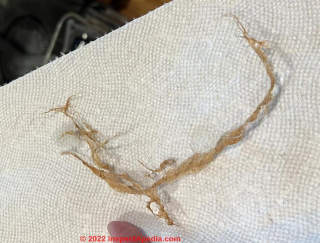 Ok, I know I said last one, but I just remembered- back in May, I pulled… this… out of the dishwasher nozzle. I pulled it out of the jet nozzle- where the water comes OUT. At the time, I thought it was hair (bizarre, and gross). But now that I’ve seen many pictures of dry rot hyphae… could this be… fungus?
Ok, I know I said last one, but I just remembered- back in May, I pulled… this… out of the dishwasher nozzle. I pulled it out of the jet nozzle- where the water comes OUT. At the time, I thought it was hair (bizarre, and gross). But now that I’ve seen many pictures of dry rot hyphae… could this be… fungus?
In one of my previous comments, I mentioned we’ve had an ongoing issue with our tap water. It started out dark rusty brown. None of our neighbors were experiencing brown water. The city came out and flushed the main line and told us to run our main spigot until it was clear. Well, it was never quite clear, and after an hour, I shut it off.
Since then, our tap water has been light orange to light yellow, depending on the day, and smells “earthy”. Sometimes it smells strongly of iron. (Plumber said all pipes are fine). I installed a “hard water” filter on the shower head, but it seems to make no difference.
Orange water everywhere. Shower. Laundry. Ice maker. Tap water. We’ve been buying bottled water and ice for 5 months! My laundry all has a slight tinge of… rust. Ugh!
Can serpula/poria get in the plumbing?
Am I crazy? Am I just grasping at straws?
On 2022-08-14 by InspectApedia-911 (mod)
@Anonymous,
When you see a very definite spike in humidity like that, that's great for diagnosing the cause.
You ought to be able to match that event and time to something going on in the building such as doors opening and closing, windows open or shut, plumbing fixtures in use, equipment turning off or on, or some other building condition or operation that would affect humidity levels indoors..
On 2022-08-14 by Anonymous
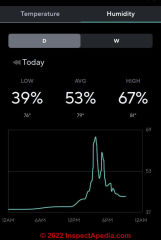 One last one for now… to add to the mystery, this is a good example of the INDOOR humidity levels, and how they fluctuate throughout the day.
One last one for now… to add to the mystery, this is a good example of the INDOOR humidity levels, and how they fluctuate throughout the day.
I am choosing a day when we were away from home, to illustrate that the bizarre fluctuation is unrelated to household activities. Here, I have the a/c thermostat set at 75 degrees, and a dehumidifier set at 40%. The dehumidifier is placed in the middle of the dampest end of the house. The entire house is about 1000 sf’.
I have humidity sensors in each room; this is just one room, but all of the rooms have this fluctuation.
EXCEPT- interestingly, an addition which used to be a carport and at some point was converted to a bonus room. That room has a concrete floor and (I presume) no subfloor. Despite having no a/c, that room keeps a fairly consistent, normal, level of humidity.
As it SEEMS like we’ve ruled out every usual source of water, I have to wonder if it is possible a “water conducting fungus” is growing between the finished floors and the subfloor. and if so, whether the fungus is not only responsible for the dampness, water damage, wood damage, powderpost beetles, yellow dust, etc- but if its need for water, OR its output of metabolic water, has a rhythm, or schedule, for lack of a better term.
From a scientific perspective this is fascinating. Living in it however is extremely frustrating. And something in this house is making me sick (my guess is mold, related to the dampness), so that’s no fun. I’d hoped this would be a minor issue/ easy fix, but so far, no one has even been able to identify the problem!
Re: spike in humidity. This is during a stretch of a few days when we were staying with a friend. No one was in or out of the house, or using any appliances, or water. There is no yard irrigation, so it’s not lawn-related either. It also seems unrelated to rain or weather. Here’s another example that’s even more puzzling:
Also note, in each of these instances, not only was it an empty house with no activity, but I had a dehumidifier set to a target 40% humidity level in the house, and another dehumidifier maintaining 45% humidity in the basement.
For it to reach 69% humidity, with the a/c running as usual, AND a dehumidifier set to maintain 40%, implies to me that an awful lot of water (something that should certainly be observable) is coming from *somewhere*… but where? We’ve ruled out all the usual suspects.
On 2022-08-14 by Tasha
It’s a little difficult to see in a photo, but can you see the large water drops on the floor? These appear several places in the house. They have a slight yellow tinge.
This is baffling to me! They appear even when no one has been in the room- not even the dog (at first I thought it was dog drool, ha). They are unrelated to any sort of rain, or household water use- laundry, bathing, dishwasher, etc.
I first noticed the droplets in the kitchen, but have since seen them appear in the dining room, hallway, and it seems that a puddle must appear under my bed overnight, because in the morning it looks like that area has been wet. I am now noticing random spreading dampness in the bathroom floor grout.
On 2022-08-14 by Tasha
Inside some trim in the kitchen. Is this dry rot/ fungus? And this is happening on the front of kitchen cabinets… is this woodworm/beetles? Fungus?
On 2022-08-14 by Tasha
Under a deck attached to the house. Is this the beginning of dry rot? Wet rot? Mold? Mildew? It looks like many yellow circles of fungus to me.
On 2022-08-14 by Tasha
I think this is an old section of larva activity? These were wriggling, so there was something going on about 5 weeks ago, but I can’t find any now…
On 2022-08-14 by Tasha
P.S. I should mention that the house has been checked by 3 different pest control people in the past 5 months- no evidence of termites. No evidence of rodents, either. At first, I thought we must have rodents peeing on the wood floors at night… but no. I’ve since seen those yellowish water spots appear, out of the blue, all day long.
On 2022-08-14 by Tasha - concerns about mysterious issues with water damage, water intrusion, high indoor humidity
I recently posted a long comment describing the mysterious issues with water damage, water intrusion, high indoor humidity, no apparent home or plumbing leaks, HVAC, water heater both new and recently serviced, plumbing fine, roof fine, no indoor condensation, etc under “white mold” with a question about the white fungus/mold on my outdoor garbage can- possibly from dry rot spores from the rapidly deteriorating soffit above.
I’m following up here with additional photos of what I’ve observed in the house and basement. First question- can I submit a sample of wood, tape lift, or actual mushroom to your lab for identification? I cannot seem to locate anyone in my state who has even heard of serpula or poria, let alone knows how to identify them. A lab test would be VERY useful!
I’ll start by posting some photos of the basement/crawlspace and the underside of a wooden deck. The basement is, surprisingly, the most consistent environment in the home when it comes to humidity. It already had vapor barrier and ventilation. Floor is concrete, walls are granite and mortar. I noticed the mortar crumbles easily.
There are many brown spots on the stone walls that might be lichen? At first I thought they were mold. But I sent a tape lift sample to a lab, and they said not mold. Did note fragments of aspergillus in that tape lift, though.
I’ve been running a dehumidifier down there since we moved in in March. With the dehumidifier, it is a fairly consistent 45% humidity. If I turn the dehumidifier off, even for one hour, humidity quickly jumps to 60%+. I’ve never let it get higher than 69%, who knows how high it WOULD go. The basement does get wet (puddles, and mud) every time it rains. The owners just let it get wet, no dehumidifier. So who knows what was already growing down there before we moved in.
In the basement, I see powderpost beetle holes in overhead beams. I don’t know if the holes are old or new, but if I had to guess, I’d say a little of both. I see what looks to me like old dry rot. And a LOT of sticky yellow powder everywhere. Frass? Spores? Mold? I don’t know.
I see old wet rot. I see what looks like some old (dried up) and new fruiting bodies. I see what looks like some other type of puffy fungus (looks a little like spray foam insulation, but it’s in weird inconsistent places that you wouldn’t spray foam) growing in holes and crevices.
When I put a moisture meter up to the joists, they read 20%, give or take a few %. This does not seem consistent, though. One day a beam seems wet, a week later it does not. Twice, I have witnessed water actually *dripping* out of those beams, where there are existing knots in the wood.
I’m sure there’s more to mention, as I post some photos it will likely jog my memory.
This is a photo from the basement looking up at the (subfloor?) and what seems to be a mushroom growing from some damp wood. (It was fleshier about a week prior, I did tear off a sample at that time.) But could not find anywhere to send it.
Thank you so much for this amazing resource.

On 2020-11-24 by danjoefriedman (mod)
Chuck:
Thank you for your generous comments and helpful discussion of the relationship between Poria and termites.
For speed and clarity I've moved all of that information to https://inspectapedia.com/mold/Poria-Relationship-with-Termites.php
and will appreciate further questions, comments, criticism, content suggestions, photos.
MERULIPORIA FUNGUS & TERMITE INTERACTIONS
On 2020-11-21 by (mod)
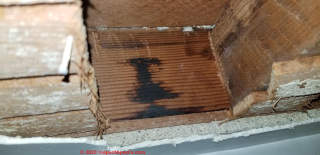 The photo isn't sharp enough for me to zoom in and see actual mold so I can only guess, but the pattern looks like a tarry stain on what is probably a sill plate of a wood-framed wall. If so I suspect there's another source of that stain other than mold.
The photo isn't sharp enough for me to zoom in and see actual mold so I can only guess, but the pattern looks like a tarry stain on what is probably a sill plate of a wood-framed wall. If so I suspect there's another source of that stain other than mold.
You are welcome to post as many photos as you like, simply by posting one photo per comment and as many comments as you need. I'm sorry for the inconvenience it's in the developer. Comment Box tool of which I'm not the developer.
On 2020-11-21 by Ms. White
I live in a house built in 1930. Seven years after I had a brand new roof put on my house, my plaster ceiling feel down in a spot due to the roofer leaving a gap in the outer wall.
I went into 1 section of the wall took 2 pictures but your site would only let me submit one.
Both the pictures have black on the wood but they both look very different.
Can you tell me if this is mold and what kind. I wish I was able to send you the other picture as well.
Question: fungi type mood coming up through the Lino type floor in my r.v.
(Aug 17, 2014) Johnwebb said:
I have fungi type mood coming up through the Lino type floor in my r.v.. This is happening close to the water tank which has leaked a few times causing damp area .
How best do I treat this
Reply:
John
By the time you see mushrooms growing out of a floor the flooring below and possibly support framing are rotted and need to be replaced. I'm sorry because probably it's going to be a bit of work, but the "damp area" you see is probably just the tip of an iceberg.
Pull up the sheet flooring, find the extent of damage, and replace as needed.
Fix the leaks.
...
Continue reading at MILDEW ERRORS, IT's MOLD or select a topic from the closely-related articles below, or see the complete ARTICLE INDEX.
Or see these
Recommended Articles
- HIDDEN MOLD, HOW TO FIND
- INSECT INFESTATION / DAMAGE - home
- MERULIPORIA HOUSE EATING FUNGUS
- MERULIPORIA FUNGUS & TERMITE INTERACTIONS
- PORIA DAMAGE PREVENTION
- LIGHT COLORED MOLD - more light coloured moulds besides white can be hard to spot
- MERULIPORIA HOUSE EATING FUNGUS
- MOLD CONTAMINATION IN BUILDINGS - home
- MOLD ON DIRT FLOORS - where we have also identified this fungus.
- PRESERVATIVE TREATED LUMBER
- ROT RESISTANT LUMBER
- ROT, DECK FLASHING ERRORS
- ROT, FUNGUS, TERMITES
- ROT, TIMBER FRAME
- ROT TYPES, BROWN SOFT WHITE
- STRUCTURAL DAMAGE PROBING
- TERMITE DAMAGE PROBING
- TERMITE IDENTIFICATION & CONTROL
- WOOD STRUCTURE ASSESSMENT
Suggested citation for this web page
MERULIPORIA HOUSE EATING FUNGUS at InspectApedia.com - online encyclopedia of building & environmental inspection, testing, diagnosis, repair, & problem prevention advice.
Or see this
INDEX to RELATED ARTICLES: ARTICLE INDEX to MOLD CONTAMINATION & REMEDIATION
Or use the SEARCH BOX found below to Ask a Question or Search InspectApedia
Ask a Question or Search InspectApedia
Try the search box just below, or if you prefer, post a question or comment in the Comments box below and we will respond promptly.
Search the InspectApedia website
Note: appearance of your Comment below may be delayed: if your comment contains an image, photograph, web link, or text that looks to the software as if it might be a web link, your posting will appear after it has been approved by a moderator. Apologies for the delay.
Only one image can be added per comment but you can post as many comments, and therefore images, as you like.
You will not receive a notification when a response to your question has been posted.
Please bookmark this page to make it easy for you to check back for our response.
IF above you see "Comment Form is loading comments..." then COMMENT BOX - countable.ca / bawkbox.com IS NOT WORKING.
In any case you are welcome to send an email directly to us at InspectApedia.com at editor@inspectApedia.com
We'll reply to you directly. Please help us help you by noting, in your email, the URL of the InspectApedia page where you wanted to comment.
Citations & References
In addition to any citations in the article above, a full list is available on request.
- Verrall, Arthur Frederic. Poria incrassata rot: prevention and control in buildings. No. 1385. US Department of Agriculture, Forest Service, 1968.
- Alexopolous, C.J., C.W. Mims, M. Blackwell. 1996. Introductory Mycology, 4th ed. (or later) John Wiley & Sons, New York. 869pp.
- Kirk, Cannon, David, and Stalpers, "Dictionary of the Fungi," 9th Ed.
- Meruliporia incrassata references: web search 4/24/11, Wikipedia and other sources:
- Index Fungorum entry for Meruliporia incrassata (Berk. & M.A. Curtis) Murrill 1942, (also see Species Fungorum: Meruliporia incrassata); Coniophoraceae - http://www.indexfungorum.org/
- Serpula lacrymans references: web search 4/24/11 Wikipedia and other sources
- Index Fungorum entry for Serpula lacrymans (Wulfen) J. Schröt., Meddn Soc. Fauna Flora fenn. 11: 21 (1885) http://www.indexfungorum.org/
- Neil Grieve. "Dry rot/Wet rot". The Conservation Glossary. University of Dundee.
- J.W. Palfreyman, The Domestic Dry Rot Fungus, Serpula lacrymans, its natural origins and biological control. Ariadne workshop 2001.
- Bagchee K. (1954) Merulius lacrymans (Wulf.) Fr. in India. Sydowia 8: 80–85
- White NA, Dehal-Prabhjyot K, Duncan JM. (2001) Molecular analysis of intraspecific variation between building and 'wild' isolates of Serpula lacrymans and their relatedness to S. himantioides. Mycological Research 105: 447–452.
- Cooke WB. (1955). Fungi of Mount Shasta (1936–51). Sydowia 9: 94–215.
- Harmsen L. (1960). Taxonomic and cultural studies on brown-spored species of the genus. Friesia 6: 233–277.
- Kotlaba F. (1992). Nalezy drevomorky domaci — Serpula lacrymans v prirode. Ceska Mykologie 46: 143–147.
- Kauserud H, Högberg N, Knudsen H, Elborne SA, Schumacher T. (2004). Molecular phylogenetics suggest a North American link between the anthropogenic dry rot fungus Serpula lacrymans and its wild relative S. himantioides. Molecular Ecology 13: 3137–3146.
- Kauserud H, Svegården IB, Saetre GP, Knudsen H, Stensrud Ø, Schmidt O, Doi S, Sugiyama T, Högberg N (August 2007). "Asian origin and rapid global spread of the destructive dry rot fungus Serpula lacrymans". Mol. Ecol. 16 (16): 3350–60. :10.1111/j.1365-294X.2007.03387.x. PMID 17688538.
- Serpula Lacrymans Fundamental Biology and Control Strategies, edited by D.H. Jennings and A.F. Bravery, Wiley, West Sussex, 1991, ISBN 9780471930587. Quotes are from page 9 of the introduction in the book.
- Olaf Schmidt (2006). Wood and Tree Fungi: Biology, Damage, Protection, and Use. Berlin: Springer. ISBN 3-540-32138-1. -
- http://www.fpl.fs.fed.us/documnts/pdf1999/carll99a.pdf Decay of Wood and Wood-Based Products Above Ground in Buildings, Charles G. Carll and Terry L. Highley
- http://cecontracosta.ucdavis.edu/Wood_Durability/What_Causes_Gaps_Between_Boards-.htm U. California - Davis on wood rot
- http://www.treesearch.fs.fed.us/pubs/viewpub.jsp?index=6360 US Forest Products Research Lab
- http://www.fpl.fs.fed.us/research-areas/rwu/rwu4723/preservation_faqs/publications.html US Forest Products Research Lab Yang and Illman's research on fungicidal tolerance of Meruliporia
- http://www.cnr.berkeley.edu/forestry/extra.html U Cal Center for Forestry
- http://www.psms.org/sporepr/sp351.html
- http://botanika.bf.jcu.cz/mykologie/polypores/list_iton.html Czechoslovakian pix - you won't see it in a house looking like this however
- http://www.pruverani.com/sellersnews.asp?ID=1204 - a typical collapsing house case
- http://www.human.cornell.edu/units/dea/extension/docs/fal96/fungi.htm Cornell University resource on wood destroying fungi
- http://www.germology.com/rot.htm soft rot, white rot, brown rot distinguished
- http://alcor.concordia.ca/~raojw/crd/essay/essay000077.html
- Atlas of Clinical Fungi, 2nd Ed., GS deHoog, J Guarro, J Gene, & MJ Figueras, Centraalbureau voor Schimmelcultures, Universitat Rovira I Virgili, 2000, ISBN 90-70351-43-9
- "Management of Powdery Mildew, Leveillula taurica, in Greenhouse Peppers," Ministry of Agriculture and Lands, British Columbia - Original source: www.agf.gov.bc.ca/cropprot/peppermildew.htm
- Fifth Kingdom, Bryce Kendrick, ISBN13: 9781585100224, - we recommend the CD-ROM version of this book. This 3rd/edition is a compact but comprehensive encyclopedia of all things mycological. Every aspect of the fungi, from aflatoxin to zppspores, with an accessible blend of verve and wit. The 24 chapters are filled with up-to-date information of classification, yeast, lichens, spore dispersal, allergies, ecology, genetics, plant pathology, predatory fungi, biological control, mutualistic symbioses with animals and plants, fungi as food, food spoilage and mycotoxins.
- Our recommended books about building & mechanical systems design, inspection, problem diagnosis, and repair, and about indoor environment and IAQ testing, diagnosis, and cleanup are at the InspectAPedia Bookstore. Also see our Book Reviews - InspectAPedia.
- In addition to citations & references found in this article, see the research citations given at the end of the related articles found at our suggested
CONTINUE READING or RECOMMENDED ARTICLES.
- Carson, Dunlop & Associates Ltd., 120 Carlton Street Suite 407, Toronto ON M5A 4K2. Tel: (416) 964-9415 1-800-268-7070 Email: info@carsondunlop.com. Alan Carson is a past president of ASHI, the American Society of Home Inspectors.
Thanks to Alan Carson and Bob Dunlop, for permission for InspectAPedia to use text excerpts from The HOME REFERENCE BOOK - the Encyclopedia of Homes and to use illustrations from The ILLUSTRATED HOME .
Carson Dunlop Associates provides extensive home inspection education and report writing material. In gratitude we provide links to tsome Carson Dunlop Associates products and services.


